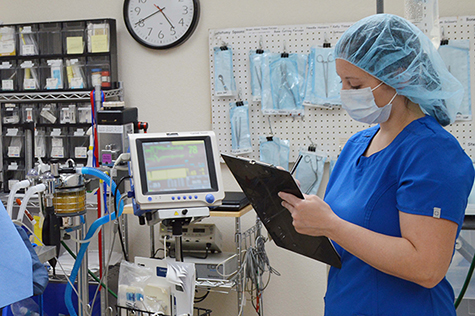What is anesthesia?

Anesthesia is the use of drugs to induce unconsciousness, loss of pain perception, and loss of voluntary muscle movement. There are many types of drugs which can be used for anesthetic purposes. Anesthesia is often induced by injectable drugs (either into the veins or muscles), and then maintained with inhalants.
Is anesthesia safe?
Anesthetic complications can occur but are rare. The generally accepted risk factor is that 1-in-100,000 animals will have an adverse anesthetic event. It’s been said that there is a higher risk of getting injured in a car accident on the way to the hospital than having a negative reaction to anesthesia.
Potential anesthetic complications may range from a mild allergic reaction to a drug, to respiratory depression, to organ failure or cardiac arrest. Risks are mitigated by carefully selecting an anesthetic protocol based on the individual pet’s health status, pre-operative bloodwork, and the procedure to be performed.
Veterinary technicians are a crucial part of providing a safe anesthetic experience. While your pet is under anesthesia, their vital parameters such heart rate, respiratory rate, temperature, blood pressure, and blood-oxygen saturation are being constantly monitored for any abnormal changes which may warrant intervention.
Sedation vs. Anesthesia?
We are often asked ‘what’s the difference between sedation and anesthesia?’ Sedation can be thought of as being on a spectrum in between ‘fully awake and conscious’ and ‘complete loss of consciousness’. Some quick, non-painful procedures can be performed with light sedation, while other more invasive procedures may require deep sedation. All surgeries require general anesthesia. Depending on the procedure to be performed and your pet’s health status, your veterinarian will determine the safest method to administer anesthesia.
What happens under anesthesia?
Your pet will first receive a thorough physical exam. Based on the pet’s history and reason for anesthesia, pre-operative bloodwork, urinalysis, and/or x-rays may be recommended to screen for a potential underlying disease. Pre-operative bloodwork is a critical tool for catching subclinical disease which may affect the optimum anesthesia protocol.
Once your veterinarian has determined the best protocol for your pet, they will be induced for anesthesia using injectable medications. If more than sedation if necessary, your pet will be intubated to maintain gas and oxygen.
Once unconscious, monitoring equipment is applied and vital parameters such as heart rate, respiratory rate, blood pressure, temperature, and blood-oxygen saturation, are monitored constantly.
When the procedure is complete, additional pain medications, antibiotics, or sedative-reversals are given. Your pet is monitored closely by a dedicated veterinarian technician until they are awake and have regained critical reflexes.
What happens after your anesthesia?
It is normal for your pet to feel a bit tired or lethargic for several hours after anesthesia. Your veterinarian will advise you on the best time to feed their next meal, follow-up care, and what to watch for at home. Generally, pets have regained full energy and are back to themselves the next day.
